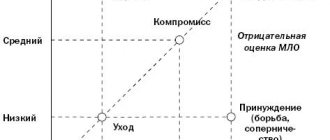With this introductory article we begin our acquaintance with Psychosophy, a typology that divides people into 24 psychotypes. This approach is very interesting and is worth our careful study. I will not describe Psychosophy itself in detail; there is a lot of material on this topic on the Internet, and you can easily figure it out on your own. I will only give the basic concepts, definitions and briefly describe the essence of the method. And of course, those points that relate to our topic of determining your purpose will be discussed in detail
Psychosophy (or psyche-yoga or Afanasyev’s typology) is a typology created by Alexander Afanasyev on the basis of Socionics (which, I hope, we will also get to in due time). Psychosophy studies the sphere of a person’s priorities, his own ideas about his inner world and his capabilities. And this is exactly what we need to determine the purpose
According to Psychosophy, the entire sphere of human existence can be divided into four aspects
Physics (F*)
- Everything related to the material world and material objects
- Attitude to your physical body and its needs
- Physical labor and work in general
- Physical strength of a person, his physical skills and capabilities
- The ability to act in the world of physical objects
- Biological aggressiveness and readiness to resolve conflicts by force
* – here and below the first letter of the aspect is indicated in brackets (F means Physics). This short abbreviation will be needed to compile psychotypes
Relationships
Psychosophy easily and logically predicts the relationships between types. The relationships are looked at for each function separately, for example, there are two types EFVL and VEFL. In terms of emotions they have relationships according to the scheme 1-2 (the first with the second), in physics - 2-3, in terms of will - 1-3 and in logic 4-4. Based on the meaning, all possible types of connections can be classified into 4 groups:
Additions (1-4, 2-3).
The strengths of one function naturally cover the weaknesses of another. This is the best combination.
Identical (1-1, 2-2, 3-3, 4-4).
They are characterized by good mutual understanding, and for strong functions, also mutual respect. But the addition does not occur.
Pseudoidentical (1-2, 3-4).
There is no good mutual understanding. People seem to be similar, but the goals of some are the means of others, which makes them fundamentally different. This is a source of misunderstanding in some cases, but not a source of conflict.
Conflict (1-3, 2-4).
There is a deep misunderstanding between these functions, which can even result in conflicts. Only because of this combination of functions can underestimation of a person appear, disrespect for him and his actions.
Already based on this description, it is clear that for each type there is a type with the best and worst relationships. For example, for the EFVL type, the best is LVFE, and the worst is VLEF. Although in theory everything is smooth and logical, in life a lot also depends on a person’s upbringing, the ability to hear other people and value trust. It seems to me from my experience that education, the ability to hear, trust are all psychosophy and can be either present or absent in each type.
Logic (L)
- This is everything that is a product of the activity of the human mind, regardless of whether it has a material embodiment or not
- The world of our ideas, fantasies, reflections
- A person’s ability to create something on a subtle level, i.e. in the mind, at the level of ideas and concepts
- Everything related to knowledge, the learning process and the transfer of knowledge
- A person’s ability to analyze, his analytical abilities
- The beauty and completeness of ideas, the value of inferences, conclusions, various types of theory and theoretical models
4th Emotion
The fourth productive function requires variety and intensity of emotional expression from other people, but can do without it. The main thing for the fourth function is that it itself does not become involved in the process for a long time. So that the minimum needs are met. Or so that Emotion comes into play when the task is beyond the capabilities of other functions. According to them, a certain “selflessness” is possible. The fourth function, like the second, is “not a pity.” And if the resources for the second seem to “not end”, then for the fourth it is different - she needs additional motivation and when it runs out, the four calms down. The needs for the fourth function are the least heard. According to the fourth function, it is easiest and most desirable to agree with the will of others, and one does not at all want to evaluate, criticize, or enter into disputes. Upon achieving results, the four do not want, unlike their superiors, to improve, continue, or finalize anything.
It is difficult for a person with the fourth emotion to empathize with someone for a long time, or rather, empathy itself is available, but it is rather inside, there is no energy to express it. There seems to be no point in showing it clearly. If someone else does, 4E won't mind. They are interested in other people's emotions, and if a person expresses them without involving others in the process, then 4E will accept them without criticism and will let them speak out if this does not contradict the wishes for other functions. They may not be interested in art, or if some area is of interest, music, for example, then the preferences of 4E will be very diverse. A person with 4E may not like some music, but if it plays in his presence, then asking him to turn it off will be the last thing that comes to his mind. 4E may be interested in exhibitions, theaters, etc., but they will show less independent initiative in this than in their other functions. Although an active, temperamental person can clearly implement 4k, the order of priorities can still be traced. The Four easily picks up confident initiatives on the part of other people.
Will (B)
- Human willpower, perseverance, motivation
- Will is the driving force that motivates a person to act in this world
- This is the core of personality, which allows you to change something both in the outside world and within the person’s personality itself.
- A sense of purpose and meaning of human existence
- The ability to set goals and achieve them, not only independently, but also to encourage (“ignite”) others to do this
The main idea of Psychosophy is that the individual considered separately from birth was given more of some qualities, and less of others. The so-called measured share. And there are no people who have a lot of everything or, on the contrary, a little of everything; there is a certain balance and distribution of these qualities. The creator distributed these strengths and weaknesses among people to create the current diversity and encourage people to interact with each other. After all, if we assume that I am completely self-sufficient, then why do I need other people? If I have everything, why should I ask others for anything? And on the contrary, if the people around them have everything, and they are 100% self-sufficient, then why should they turn to me for help?
For example, someone is talented in art, but has problems with logical thinking. Someone is very handsome and physically strong, but at the same time he can be a completely weak-willed person. Someone has a brilliant mind and super analytical abilities, but at the same time he is physically very weak. And we constantly see this sad picture of imperfections and incompleteness in real life. All these jokes about blondes, military men, scientists, etc. They just show our disappointment when we see one bright area of a person’s personality, expecting that other areas of a person are just as attractive and strong. But alas, no! Beautiful blondes turn out to be stupid. Brilliant scientists turn out to be weaklings and absolutely do not know how to dress beautifully. Sensual actors who evoke a storm of emotions and experiences turn out to be weak-willed and cowardly in real life. And brave military men turn out to be narrow-minded and cannot show creativity and imagination
And all these described types, who have become heroes of jokes, precisely confirm this model of Psychosophy that God has endowed someone with talents in one thing and deprived them in another.
These above four aspects of being (Physics, Logic, Emotions, Will) are arranged into four places of personality strength or functions. And each function has its own qualities: there are strong and weak, dominant or adaptable, effective and processional. For some function a person is very strong, bright and categorical, for some function he is valued by society, there is one that is very painful for him, and there is one that is completely unimportant for him
Below is a brief description of these features. Like the aspects of being, there are also four functions. And to determine a person’s psychotype according to Psychosophy, we need to arrange the above-described aspects according to the functions described below
How to type
Having become acquainted with personality typology, a reasonable question arises: how exactly can you find out the type (type) of a particular person? Here I would highlight 4 methods:
Observation
behind a person and identifying features that exclude certain options for the arrangement of functions until the type becomes clear. For example, you know that a person likes to build theories and prove something or tell others, this is almost guaranteed to exclude 4L. If a person does not stand out for his special romanticism and great vividness of emotions, then this is not 1E, and if it seems that the person shows himself weakly emotionally, then he is not 2E. In this way, step by step, you can find out the entire type of person.
Typing by dichotomies.
The following dichotomies for functions are distinguished:
- strong (1 and 2) – weak (3 and 4)
- productive (1 and 4) – processional (2 and 3)
- dominant (1 and 3) – adaptable (2 and 4)
In a strong function a person is always confident in himself, while in a weak function there is always an element of uncertainty. The productive function is not inclined to dialogue, but rather to a monologue and a speedy completion, while the processive function, on the contrary, is interested in acting and trying different options. The dominant one is often the reason to act (confidently or uncertainly), she has a lot of ambitions, and the adapter calmly accepts everything. Based on a person’s behavior, one can often notice certain dichotomies, which is very helpful in typing.
Partial typing.
Sometimes you need to type quickly, even if not completely. For example, you see a person who clearly shows that he has 1B. This already means that he does not have 1L, not 1F and not 1E. Also from this, for example, it may follow that if you do not have a 3B, then most likely there will not be an acute conflict with him, and if you have a 3B, then you need to be on the outside, because some of his actions may seem too harsh and unpleasant for him. you.
Test.
For typing you can use the test.
1st function (“Hammer”*)
The main function of a person. He is most confident in it and perceives it as the most valuable. In the area of this function, a person often expresses himself in excess, without noticing the reactions of others. He doesn’t care about the opinions of others, he is sure that everything he does according to the 1st function is done perfectly and correctly.
Options:
- High function
- Dominant
- Effective
- I am OK, You are not OK
* – in parentheses are the names of the functions that Afanasyev himself gave them
This allegorical comparison with the “Hammer” shows that a person categorically breaks through everything in his path with this strong dominant function. He doesn’t care about other people’s opinions in this area, he is sure that he is right. In fact, he may be right or wrong, the important thing is that he has this unshakable confidence in his rightness. He considers himself an expert in these matters, and the rest are fools. This is how the position “I am OK, but you are not OK” is manifested. The function is high, i.e. a person has a lot of strength in this area, and she is focused on results
Arrangement of values in Psychosophy
This system is based on the prioritization of values of the individual. The four main values of psychosophy are: Will (spirit), Logic (mind), Emotion (soul) and Physics (body). Depending on what is most important to a person, his psychological portrait emerges.
Those who can count quickly have already realized that if you have four values, you will get twenty-four options for their location relative to each other. All these 24 options were described in his book, “Syntax of Love,” by the creator of the typology, Afanasiev .
I described it quite well, although biased. In his opinion, it turned out that there is good and bad prioritization. There were types that Afanasyev considered, for one reason or another, unworthy, and even dangerous. Well, “the giraffe is big, he knows best”! But we’ll still try to figure it out a little more objectively.
2nd function (“River”)
A normative function that knows how to correlate its interests in a given area with the interests of the people around it. This is the most moderate and harmonious function. A person in the second function has the strength and desire to share this with others
Options:
- High function
- Adaptable
- Processional
- I am OK, You are OK
The second function is called “River”, because this allegorical description of the 2nd function is most suitable for comparison with a deep river. The flow of such a river is smooth, even, and calm. This river feeds everything that grows on its banks with life-giving moisture. The very sight of the river evokes a peaceful state. The function is high - therefore, a person in this area, as in the case of the 1st function, also has a lot of strength. But unlike the 1st function, a person in his 2nd function is ready to adapt to those around him, to listen to the opinions of others. The second function represents harmony. A person considers himself to be quite good in this area and those around him too (I am OK, You are also OK). A person is ready to share this power with people, and for him the process is more important than the result
Functions of psychosophy
The position occupied by one or another aspect in the personality structure determines a person’s attitude towards himself and the world around him. Let's look at each of the four functions.
1
Hammer function
The most powerful, basic and dominant function of a person. Subjectively, it is perceived as the most valuable. Often a person strives to express himself in abundance and achieve the greatest success. Afanasyev calls this function “a gift to yourself.” Often the desire for self-realization in the aspect occupying this position is so high that a person is unable to adequately perceive feedback.
2
River function
This function is more moderate. Here a person is already able to correlate his needs with the reactions of others. In view of this, the second function is considered the most harmonious, because brings satisfaction and benefit to both the individual himself and the people around him.
3
Ulcer function
The name of this function very clearly describes its content. The person has a certain need to satisfy the aspect occupying this position, but is not confident in himself. He is afraid of criticism from others, their reactions and, as a rule, has a low estimate of his abilities. As they say, whether you want it or not, a person often suffers because of a frustrated third function.
4
Trifle function
This is the most insignificant aspect, and therefore there is no motivation to satisfy it. A person does not give importance to the fourth function and is realized within it to the extent necessary to achieve results in the remaining functions. Since the latter function is not fundamental, a person often easily agrees with someone else’s opinion regarding the aspect occupying this position.
As you understand, most often people have difficulties with the first and third functions. In the first case, you need to learn to hear other people, sometimes listen to them, and in the second, you should evaluate how important the aspect that occupies the third function is for you, and either overcome your uncertainty or concentrate on the first two functions.
How to determine your psychotype? To do this, you need to arrange the aspects in order from most to least priority (that is, in order of functions) and get a sequence of letters, for example, EFVL or VBLVE - this is your psychotype. As in socionics, in psychosophy there are pseudonyms for each type.
Pseudonyms of psychosophy look like this:
As for compatibility, to check it you need to determine your psychotype and the psychotype of your partner, and then select the appropriate cell of the table on this site. For each pair of types, there are interaction guidelines that will tell you how to behave and what to pay attention to. If you feel that your relationship has lost its former warmth and harmony, this compatibility chart can help you achieve the same harmony. And even if everything is fine with you and your partner, the practical tips on this site will bring you even closer to each other.
But remember not to take compatibility results too seriously. Rather, think of them as food for thought, a tool for self-knowledge, personality development and relationships.
We wish you success!
3rd function (“Ulcer”)
Painful, restless, insecure function. On the one hand, a person feels the need to prove himself in this area or get something in it, but on the other hand, he does not have the strength to fully demonstrate this or achieve this on his own. A person is not confident in his abilities and is afraid of criticism and negative evaluation. This function is good at seeing the shortcomings of others in a given area and readily criticizes them.
Options:
- Low function
- Dominant
- Processional
- I am not OK, you are not OK
An “ulcer” is the most painful area of a person. He is not strong in this function, but he has a very strong need for it, to receive it or to express himself in it. But since the function is low, the person does not have the strength to get it on his own. Therefore, a person needs help in this area from the people around him. This is a person's area of uncertainty. He understands that he himself is weak in this zone, and at the same time he doesn’t have much trust in those around him (I’m not OK and you’re not OK either). And we get such a deeply unhappy beggar, who is ashamed to ask and cannot help but ask, and in addition to this, he is very attached to what he asks, so any refusal or unwanted scenario is very painful for him
Fundamentals of psychosophy or 4 spheres of Being
Introduction
Psychosophy is a typology created by A.Yu. Afanasyev in the mid-80s. It has four aspects: Will, Logic, Emotion, Physics, which can be roughly compared with the four spheres of Existence: Spirit, Mind, Soul and Body. All aspects are located in the mental structure of the individual in a certain way. Any aspect can be number one on the priority list (or otherwise occupy the first function), second (occupy the second function), third or fourth (occupy the third or fourth function), but no one aspect can occupy two seats for one person at a time. The position in which an aspect falls determines how it will manifest itself in a person, how a person will relate to everything connected with it, and how subjectively valuable the sphere of this aspect will be for him.
In total, there are 24 possible options for arranging aspects, and, accordingly, 24 personality types. Personality type is indicated by the first letters of the names of the aspects, listed from the first (most significant) to the fourth. In addition, just as in socionics, there are pseudonyms for types, but the letter designation is still preferable. For example, a type with the order of functions Will, Logic, Emotion, Physics is designated VLEF and has the pseudonym “Socrates”.
Aspects of psychosophy
- Will - a sense of purpose, the meaning of a person’s existence, his place in the world, the perception of life’s tasks and desires. Will is the core of personality, the driving force that forces other components of the world to change.
- Logic is the world of ideas, everything that is a product of the activity of the human mind, regardless of whether they have material embodiment or not. The position of Logic determines the degree of subjective value of inferences, beauty and completeness of ideas and concepts, regardless of whether.
- Emotion is the sphere of a person’s internal experiences: feelings, emotions. In addition, Emotion is responsible for the attitude towards art and the beauty of the surrounding world in general.
- Physics is the world of everything material. The position of Physics is responsible for the attitude towards one’s own body and its needs, the importance of possessing material goods, physical labor and work in general, for biological aggressiveness and readiness to forcefully resolve conflicts.
Functions in psychosophy
- The first function (“hammer”) is the main function of a person. He is most confident in it and perceives it as the most valuable. In the area of this function, a person often expresses himself in excess, without noticing the reactions of others.
- The second function (“river”) is a normative function. The most moderate and harmonious, she knows how to correlate her interests in this area with the interests of the people around her.
- The third function (“ulcer”) is painful, restless, and unsure of oneself. On the one hand, a person feels the need to prove himself in this area, on the other hand, he is not confident in his abilities and is afraid of criticism and negative evaluation. On the other hand, this function is good at seeing the shortcomings of others in a given area and readily criticizes them.
- The fourth function (“trifle”) is the least significant for a person and therefore calm and detached. Often, according to it, a person does not have his own preferences in this area and easily adapts to others.
All functions can be divided according to three criteria:
- productive (first and fourth) and processional (second and third, with the third being superprocessional);
- dominant (first and third) and adapting (second and fourth);
- high (first and second) and low (third and fourth).
A complete list of all types and their aliases are presented in the table below:
| 1st function | 2nd function | 3rd function | 4th function | Type and its nickname |
| Will | Logics | Emotion | Physics | VLEF ("Socrates") |
| Physics | Emotion | VLFE ("Lenin") | ||
| Emotion | Logics | Physics | WELF (“Akhmatova”) | |
| Physics | Logics | VEFL (Tolstoy) | ||
| Physics | Logics | Emotion | VFLE (Napoleon) | |
| Emotion | Logics | VFEL (“Tvardovsky”) | ||
| Logics | Will | Emotion | Physics | LVEF (Einstein) |
| Physics | Emotion | LVFE (“Lao Tzu”) | ||
| Emotion | Will | Physics | LEVF ("Pascal") | |
| Physics | Will | LEFV ("Augustine") | ||
| Physics | Will | Emotion | VBLHEP (“Plato”) | |
| Emotion | Will | LFEV (“Berthier”) | ||
| Emotion | Will | Logics | Physics | EVLF (“Ghazali”) |
| Physics | Logics | EVFL ("Pasternak") | ||
| Logics | Will | Physics | ELVF (Andersen) | |
| Physics | Will | ELFV ("Rousseau") | ||
| Physics | Will | Logics | EFVL ("Pushkin") | |
| Logics | Will | EFLV (“Bukharin”) | ||
| Physics | Will | Logics | Emotion | FVLE ("Goethe") |
| Emotion | Logics | FVEL (Chekhov) | ||
| Logics | Will | Emotion | FLVE ("Aristippus") | |
| Emotion | Will | FLEV ("Epicurus") | ||
| Emotion | Will | Logics | FEVL ("Dumas") | |
| Logics | Will | FELV (Borgia) |
We further recommend:
- Aspects in psychosophy
- Intertype relationships in psychosophy
- Psychosophy for skeptics: description of functions
- A detailed introduction to psychosophy on the website TYPOLOGIES.RU
- Descriptions of functions and types in the book by A.Yu. Afanasyev "Syntax of Love"
4th function (“Trifle”)
This is the least significant function for a person, and therefore it is calm and detached. Often, according to it, a person does not have his own preferences and easily adapts to others’
Options:
- Low function
- Adaptable
- Effective
- I am not OK, you are OK
A “trifle” is a function to which a person does not attach much importance. He understands that he is weak in this area, but, unlike the 3rd function, this does not bother him at all. “Well, I don’t know how to do this, and I don’t really need it.” According to this function, a person prefers to trust the opinion of external experts (I am not OK, You are OK). As a rule, a person chooses ready-made solutions, what others advise him. At the same time, a person is not inclined to improve or change anything in what is offered to him - he accepts it as is. “They said this shirt is very fashionable this season. I'll wear it well! And without any additional bows or fashionable frills.”
Types
To understand what a specific type is, it is enough to use what is written above, namely, to connect the meaning of each function with its position in the type. For example, we have an EFVL type: emotion comes first (1E), then 2F, 3B and 4L. This means that such a person is emotional, lives by emotions, which are very vivid and contagious to others. 2F makes him an active person who loves a variety of physical sensations, is well versed in food, beauty, tastes, is attentive to others, and constantly pays attention to how physically comfortable a person is. 3B means that social fulfillment and respect from others are very important for a person; insults are painfully perceived. 4L - this means that a person is not inclined to build complex logical schemes and theories about everything around him, and is also not inclined to listen to them, in other words, even if everything is told and explained to him logically, he will still do it his own way.
What was described above is just a small and far from complete example of how to build a type description yourself, based on the sequence of functions. (you can also see my type descriptions at this link: ...)
2E
The Second Emotion can and wants to react freely and variedly to various emotional manifestations of itself and others. It is interesting to track emotions in others and influence them. They are interested in the mood of other people, their emotional states. They pay attention to what emotions they themselves experience. They love communication, bright and varied. When emotions are expressed around. Accept a variety of expressions of emotions without criticism, support emotions, maintain communication. They pick up on the moods of the surrounding world and are impulsive. They are interested in the inner world of other people. Emotions are important, although often people with 2E claim that they are not necessary. They can and do know how to create a mood, and they are especially willing to do this at the request of other people or for other people so that they like it.
With strong and weak ethics:
With strong socionic ethics, 2Es turn out to be very flexible in matters of ethics, they have both the ability and energy to solve complex ethical situations that may be quite interesting to them.
They feel the ethics of the situation, relationships between people, moods. And they may well influence them subtly and qualitatively. With extroversion, these are very sociable people, constantly looking for new acquaintances, contacts, new situations that are pleasant and interesting to them. With introversion, these are very family people who love their relatives and know how to maintain the comfort of family life and mood. Author: Yulia Kolesnichenko








